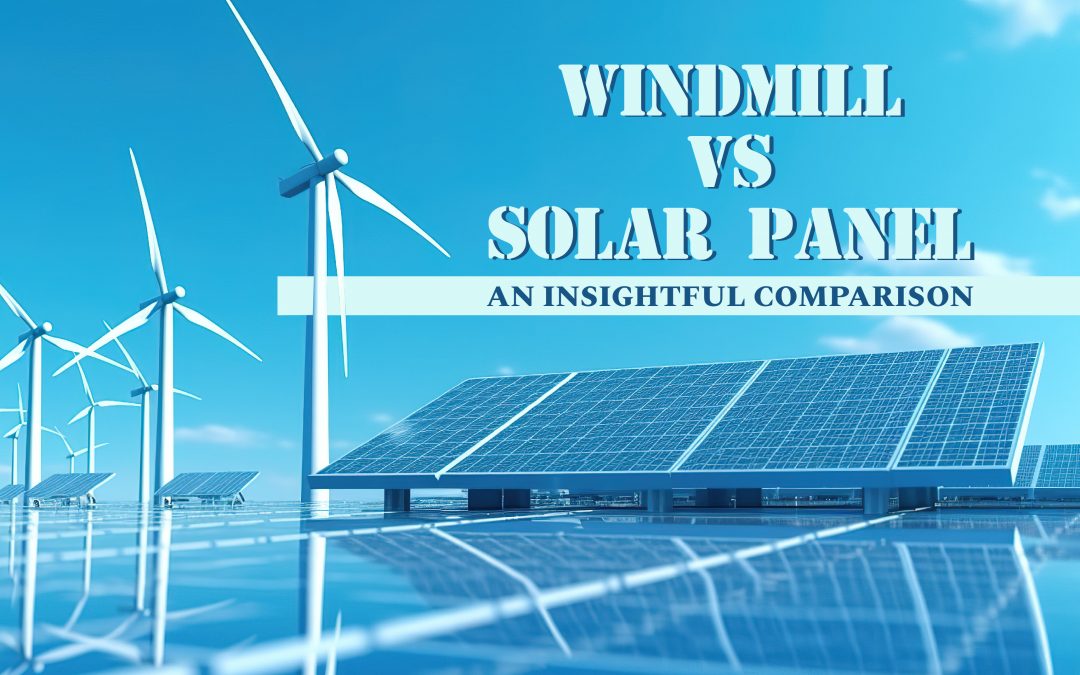As the world continues to shift towards renewable energy sources, two of the most prominent technologies in the field are windmills (or wind turbines) and solar panels. Both play crucial roles in reducing our reliance on fossil fuels, but they operate differently, have distinct advantages and disadvantages, and are suitable for various applications. This blog will provide an insightful comparison between windmills and solar panels to help you decide which might be the better option for your energy needs.
How They Work
- Windmills (Wind Turbines): Wind turbines convert the kinetic energy of wind into electrical energy. When the wind blows, it turns the blades of the turbine, which spins a rotor connected to a generator. This generator produces electricity. Wind turbines are most effective in areas with strong, consistent winds, such as coastal regions or open plains.
- Solar Panels: Solar panels, on the other hand, harness sunlight and convert it into electricity through photovoltaic (PV) cells. When sunlight hits these cells, it excites electrons, creating an electric current. Solar panels work best in areas with abundant sunlight and can be installed on rooftops, open land, or even integrated into building materials.
Efficiency and Energy Output
- Wind Turbines: The efficiency of wind turbines depends heavily on wind speed and consistency. In optimal conditions, a single wind turbine can generate a significant amount of electricity, often enough to power several hundred homes. However, in areas with low wind speeds, turbines may produce little to no energy.
- Solar Panels: Solar panels have a more consistent energy output, as long as there is sunlight. Their efficiency has improved significantly over the years, with modern panels converting around 15-22% of sunlight into electricity. However, energy production decreases on cloudy days or at night, necessitating storage solutions or backup systems.
Business Models: Windmill vs. Solar Panel
The business models for wind and solar energy companies depend significantly on the scale of operation, the geographic location, and the target market.
- Windmill Business Model: Wind energy companies generally operate large-scale wind farms. They generate revenue by selling electricity directly to the grid or through long-term power purchase agreements (PPAs) with businesses and utilities. The initial capital expenditure is high, but the long-term returns, driven by consistent energy production and government incentives, make this model sustainable in wind-rich areas.
- Solar Panel Business Model: Solar energy companies benefit from more diverse business models. These include residential rooftop installations, large-scale solar farms, and community solar projects where multiple users share a larger solar facility. Innovative models like pay-as-you-go and leasing have democratized access to solar energy, particularly in urban and rural areas with abundant sunlight.
Insights and Scope Based on Location
Location is a critical factor in determining the effectiveness and profitability of windmills and solar panels.
- Wind Energy Insights: Wind energy is most effective in areas with strong and consistent winds, such as coastal regions, open plains, and high-altitude locations. Offshore wind farms, particularly in Europe and parts of Asia, are gaining popularity due to higher wind speeds and the availability of space. However, wind turbines are less viable in densely populated urban areas or regions with low wind potential, limiting their application.
- Solar Energy Insights: Solar panels are more location-flexible compared to wind turbines. They are highly effective in regions with high solar insolation, such as deserts, equatorial regions, and parts of the Southern Hemisphere. Countries like India, Australia, and the southwestern United States are ideal for solar farms. Even in less sunny regions, solar panels can be viable due to advances in PV technology, making them suitable for a broader range of locations, including urban environments.
Growth Trends and Opportunities Based on Location
The global shift towards renewable energy has led to rapid growth in both the wind and solar sectors, but this growth is uneven across different regions.
- Wind Energy Growth: The wind energy market is expanding rapidly in regions with strong wind resources, such as Europe, North America, and China. Offshore wind, in particular, is expected to grow at a CAGR of around 10-12% from 2023 to 2030, driven by technological advancements and favorable policies. However, in regions with limited wind potential, such as parts of Africa and Southeast Asia, growth is slower, and wind energy remains less prevalent.
- Solar Energy Growth: The solar energy market is experiencing widespread growth, particularly in sunny regions like Africa, the Middle East, and Latin America. With a projected CAGR of 20-25% through 2030, solar energy is becoming increasingly accessible due to falling costs and technological innovations. In contrast to wind energy, solar panels can be effectively deployed in a wider range of locations, making them a more universally applicable solution.
Automation and AI in Wind and Solar Energy
Automation and AI are playing crucial roles in optimizing wind and solar energy production, enhancing efficiency, and reducing operational costs.
- Wind Energy Automation: In wind energy, AI is used for predictive maintenance, turbine optimization, and energy forecasting. Automated systems monitor turbine performance in real-time, identifying potential issues before they become critical, thus reducing downtime. Drones and robots are increasingly used for turbine inspections, especially in offshore installations, improving safety and efficiency.
- Solar Energy Automation: AI and automation are equally transformative in the solar industry. AI-driven software optimizes panel placement, predicts energy output, and identifies faults in real-time. Automated cleaning systems, particularly in desert regions, maintain panel efficiency by removing dust and debris. Additionally, AI helps integrate solar energy into smart grids, optimizing energy distribution based on real-time demand and weather conditions.
Upcoming Trends and Location-Based Opportunities
- Hybrid Renewable Energy Systems: Combining wind and solar energy in hybrid systems is an emerging trend. These systems are particularly effective in regions with variable weather patterns, providing a more reliable energy supply. For example, a hybrid system might be ideal in coastal regions where both wind and solar resources are abundant.
- Floating Solar Farms: Floating solar farms are gaining traction in countries with limited land availability but abundant water resources, such as Japan and Singapore. These installations are particularly advantageous in tropical and equatorial regions with high solar insolation.
- AI-Powered Energy Grids: Smart grids, enhanced by AI, are being developed to better manage the integration of wind and solar energy. These grids are particularly important in regions with high renewable energy penetration, such as Europe and California, where they help balance energy supply and demand more effectively.
Conclusion
The choice between windmills and solar panels largely depends on the geographic location and specific energy needs of a region. While wind energy is ideal for areas with strong, consistent winds, solar energy offers more flexibility and is suitable for a broader range of environments. Both technologies are essential to the global energy transition, and as automation and AI continue to advance, the efficiency and scalability of these solutions will only improve.
Investors, entrepreneurs, and policymakers should consider these location-based insights when planning renewable energy projects. By leveraging the strengths of wind and solar energy in the right locations, we can move closer to a sustainable energy future.












